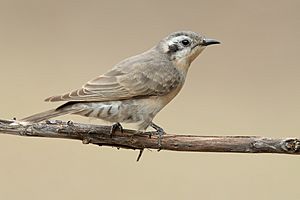Black-eared cuckoo facts for kids
Quick facts for kids Black-eared cuckoo |
|
|---|---|
 |
|
| Conservation status | |
| Scientific classification | |
| Genus: |
Chrysococcyx
|
| Species: |
osculans
|
| Synonyms | |
|
Chalcites osculans |
|
The black-eared cuckoo (Chrysococcyx osculans) is a special type of cuckoo bird. It belongs to the Cuculidae family. These birds live all over Australia. They also travel to eastern Indonesia and southern New Guinea. You usually see them alone or in pairs. Black-eared cuckoos don't build their own nests or raise their chicks. Instead, they lay their eggs in the nests of other birds. The other birds then raise the cuckoo chicks.
Contents
What Does the Black-eared Cuckoo Look Like?
Black-eared cuckoos are small birds. They weigh about 30 grams, which is like a few pieces of candy. They are about 19 to 20 centimeters long. That's about the length of a pen. Their backs are a dull grayish-brown color. They have a clear black stripe that goes from their beak to their neck, right across their eyes.
Their bottom (rump) is pale white. Their chest area is a light salmon color. Their feet and legs are black, and their eyes are brown. The beak is black. The top of their tail is grey-brown with white tips. Underneath, the tail is creamy with brownish stripes. What makes them special is that their back feathers are not shiny or metallic. This helps tell them apart from other small cuckoos in Australia.
Young black-eared cuckoos, called juveniles, are not as brightly colored. Their eye-stripe is also more brown.
Where Do Black-eared Cuckoos Live?
These cuckoos are common in most parts of Australia. However, you won't find them in very wet coastal forests. They mostly live inland from the Great Dividing Range. This includes areas in Victoria, New South Wales, and Queensland. Sometimes, a few birds, called vagrants, are seen in Tasmania.
Black-eared cuckoos breed in southern Australia. This is below the 23rd parallel south line. Some of these birds stay in southern Australia during winter. But many others fly north. They travel to Northern Australia, Indonesia, and PNG.
What Kind of Places Do They Like?
Black-eared cuckoos prefer dry, open forests and scrublands. They also like areas with mallee trees, mulga, lignum, saltbush, and thick bushes near rivers. They like to fly directly between small trees and shrubs. You won't often see them in very large trees or in humid places.
What Sounds Do They Make?
Baby cuckoos, called chicks, make a chirping sound. Adult cuckoos have a special call. It sounds like "feeeuw" or "pee-o-weer." This call goes down in pitch and sounds a bit sad. It's lower than the call of the Horsfield's Bronze-Cuckoo. They might make this sound once or repeat it. During courtship, when male and female birds are trying to find a mate, you might hear a "pee-o-wit" call. Male cuckoos often call from high branches. But you can also find them calling from lower branches.
What Do Black-eared Cuckoos Eat?
Black-eared cuckoos eat many different kinds of insects. Their diet includes beetles, flies, hemiptera (like cicadas and aphids), and sandflies. They have even been seen eating hairy caterpillars! Most of their food is found on the ground. However, they also look for food in trees and bushes.
How Do They Raise Their Young?
Breeding Season
The time when black-eared cuckoos breed changes. It depends on the rain and where they are in Australia. In the drier inland areas, breeding starts earlier in the year. In the west, it can begin around June. In the east, it might start later, around August. The breeding season usually ends in October in the west and December in the east.
During courtship, male and female cuckoos call to each other. The female starts with a loud call. Then, as the male gets closer, her calls become quieter. The male cuckoo will also feed the female during this time.
Cuckoo Eggs
Black-eared cuckoos are known as brood parasitic birds. This means they lay their eggs in the nests of other bird species. They usually choose nests that are enclosed or dome-shaped. They often pick nests of small passerine birds. Studies show they especially like the nests of speckled warbler and redthroat birds. Their eggs have also been found in the nests of fieldwrens, thornbills, scrubwrens, and heathwrens.
When a female black-eared cuckoo lays her egg, she often removes one of the host bird's eggs. The cuckoo's eggs are amazing! They are colored and sized to look just like the host bird's eggs. Sometimes, they are so similar that you can only tell them apart by rubbing the egg. This can remove the brown color from the cuckoo egg. Because of this, the host birds raise the cuckoo chicks as their own. Speckled warblers have been seen feeding black-eared cuckoo chicks. After at least 18 days, the young cuckoo chick will leave its host's nest.
See also
 In Spanish: Cuclillo de orejas negras para niños
In Spanish: Cuclillo de orejas negras para niños


